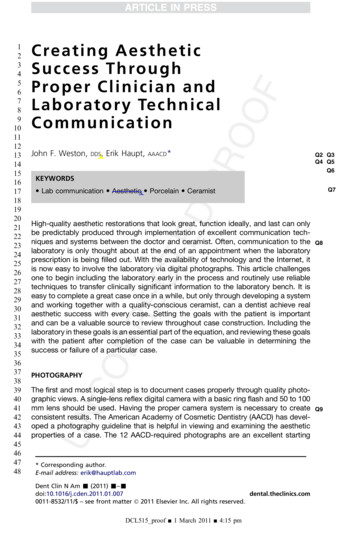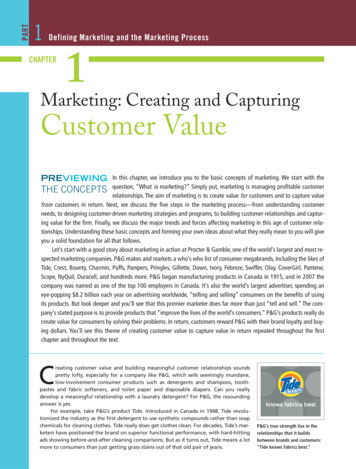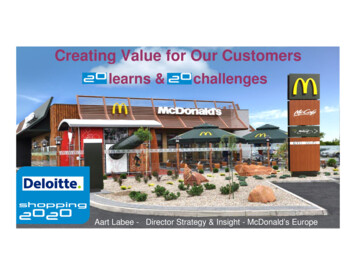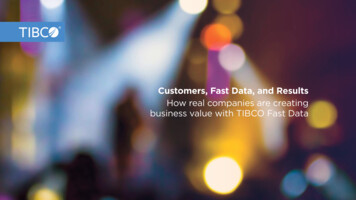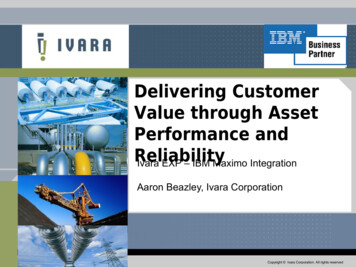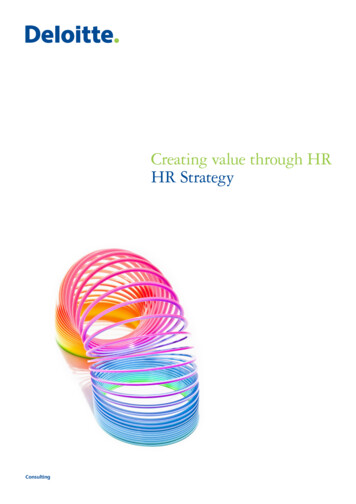
Transcription
Creating value through HRHR StrategyConsulting
HR StrategyOne of the key success factors of high performing organisations is putting their people first. Today HR executives arechallenged to develop efficient and effective, simple yet powerful solutions to the people side of business. However itremains difficult to determine the exact contribution of the HR function to achieve these objectives.Based on the HR Strategy Framework, Deloitte is uniquely positioned to assist your organisation to strengthenits strategic role and contribution of your HR function to ensure the execution of business strategy. Our 10-stepapproach helps organisations to define and execute an effective HR strategy as well as develop and deliver servicesand capabilities that today's organisations need to survive and grow.Deloitte HR Strategy FrameworkDefinehumancapitalvalueDefine human capital value1. Understand the business strategy2. Define HR strategyAlign HRproducts andservicesAlign HR products and services3. Segment HR customers4. Prioritise HR investments5. Design HR servicesDeliver valueDeliver value6. Ensure right HR service delivery model7. Establish right HR capabilities8. Improve HR operational excellence continuously9. Build HR brand10. Measure impact of HR products and servicesChart 3 (Line)3000225002000
DefinehumancapitalvalueAlign HRproducts andservicesDeliver valueDefine human capital valueThe first step towards an effective HR strategy is to define value and to understand how business value is created.This requires a deep insight into the overall business environment as well as a clear understanding of the organisation’s overall business strategy.Step 1: Understand the business strategyUnderstand market forces, trends and the business strategy and identify their impact on the HR strategy and prioritiesrequired to execute the business strategy.Step 2: Define HR strategyProvide a roadmap for creating a unique competitive advantage by outlining how the organisation will leverage theorganisation’s human capital to address business challenges and achieve business objectives. Translate your organisation’s strategy into an effective and actionable HR strategy, priorities and business plan Translate your HR strategy into key people initiatives and programs Identify the best ways to attract, motivate, and retain new and existing workforce segmentsAn effective HR strategy provides a roadmap to create value through the organisation’s workforce. It also includesguidelines for the organisation to follow when competing for new talent or retaining existing talent. These guidelinescan cover a broad range of issues, such as which skills and competencies are most critical for achieving future goalsand objectives, how to source talent (grow or buy), and how to create and maintain a high-performance culture.Deloitte helps organisations to focus on people and HR, to identify the most practical ways to get things done and toensure that your Human Capital initiatives deliver their intended business value. The Deloitte enterprise value map forHuman Capital makes this process easier by accelerating the identification of potential improvement initiatives anddepicting how they can contribute to greater shareholder value.Deloitte enterprise value mapShareholder valueRevenue growthVolumePricerealisationOperating marginSpellinggeneral &administrationCost ofgoodsoldAssest efficiencyIncometaxesProperty,plant &equipmentInventoryExpectationsReceivables& payablesCompanystrengthsExternalfactorsHR Strategy Consulting3
DefinehumancapitalvalueAlign HRproducts andservicesDeliver valueStep 3: Segment HR customersIdentify the critical workforce segments and tailorspecific programs and services. Define and determine which workforce segments aremost critical to achieve the desired results Assess the needs of each workforce segment anddraw up programs and services tailored to their needsStep 4: Prioritise HR investmentsIdentify all HR projects and understand their expectedcosts, benefits, and primary focus to properly allocatescarce resources. Identify and develop prioritisation criteria that arealigned with the organisation’s strategy and priorities Analyse the cost, benefit and risk of delivering eachoffering across the workforce life cycle Allocate funding for parts of the people servicesportfolioThe HR function should focus on value-adding activities to support the execution of the business strategyand objectives. HR leaders are asked more frequently tomeasure and improve the efficiency and the effectiveness of their HR function. However, understanding andmanaging sources of cost and value creation can be achallenging task. Several factors need to be taken intoconsideration, including the key deliverables that are tobe used in a selected organisation and the investmentsin HR practices and programs that drive these outcomes.Furthermore the criteria for prioritising HR investmentsneed to be defined to ensure the greatest return oninvestment for the organisation. Finally, HR services andactivities that should be reinforced or created need to beidentified as well as those that should be scaled back oreliminated completely.4Human Capital Cost Management is a Deloitte serviceoffering which aims to identify, measure and managethe sources of cost and value creation. This methodentails a precise evaluation of the allocation of resources(e.g. money, FTEs, time) within the HR function, allowingthe client to measure and track the actual and expectedcosts and benefits of existing HR activities and projects.Consequently, these HR activities and projects can beprioritised in accordance with the cost-benefit analysis.HR Prioritisation Matrix - IllustrationHighRe-examine InvestmentIdeal PositionTPerformanceAlign HR products and servicesOnce a strategic direction has been defined, theorganisation must review its HR policies, programs andpractices to ensure they are aligned with the defined HRstrategy.TTCTCCCCLowStay the CourseLowIncrease PerformanceMediumStrategic ValueHR CapabilityCurrent stateTalent strategiesCLearning & developmentCChange management and transformationCOrganisational strategiesCHR strategy and servicesCHighTargetTTTTTStep 5: Design HR servicesDesign and implement HR solutions that are critical toensure the execution of the HR strategy for every phaseof the workforce life cycle. Perform an HR process analysis and identify all HRprocesses that should be streamlined or reengineered Analyse the current people services portfolio, (re)design and implement HR services and solutions
DefinehumancapitalvalueAlign HRproducts andservicesDeliver valueprndVemorerocspseBuInteRetireeanagers & coyPolicies,esocBusiness&HR strategiesservicesmeel agree nts & met-levricsicevreMag & analyticsortinRepoyeesEmpedSharsservieGovernaThe Deloitte HR service delivery framework includes thekey elements that should be considered to (re)designan effective and efficient HR service delivery model. Thestarting point of the framework consists of the businessand HR strategies and the identification of the uniqueneeds and requirements associated with each customersegment, such as employees, managers, executives ornew hires. Next, the framework emphasises HR’s variousroles by focusing on how service is delivered throughretained and outsourced HR roles. Finally, the requiredtechnology and business enablers are identified andconsidered as key variables in the (re)design of the HRservice delivery model.Centee rsrs oa rt nfespsxpmoeCust erseis nsrtiMore than ever it is critical for every organisation toquestion - and if necessary - revise the way the HRfunction is organised. This implies the assessment of theorganisation’s current and future ability to support thebusiness and to execute the defined corporate strategy.To do so, organisations can rely on a wide range ofchoices to deliver their HR services and solutions.eatgrHR pogiesrtalnolo&sechelfrolesRtHdNon-empl Analyse the current HR service delivery model andassess its ability to effectively meet the organisation’sneeds and objectives Define specific roles, governance mechanisms, anddelivery options Identify key delivery enablers such as systems,processes and infrastructureEnablersrsgenaStep 6: Ensure right HR service delivery modelThink through people-related business challenges todesign the right HR service delivery model.HR service delivery frameworkceDeliver valueConverting HR strategies and initiatives into tangiblebusiness value requires the appropriate deliveryapproach, a solid foundation of HR capabilities andinfrastructure and the definition of business-drivenperformance measures to track whether the expectedresults are being delivered.Based on the HR Strategy Framework,Deloitte is uniquely positioned to assistyour organisation to strengthen itsstrategic role and contributionof your HR function to ensurethe execution of business strategy.HR Strategy Consulting5
DefinehumancapitalvalueAlign HRproducts andservicesDeliver valueStep 7: Establish right HR capabilitiesIdentify and build the advanced skills, competencies andcapabilities required for HR to fulfill its strategic role. Identify the skills and competencies required to deliverthe HR Strategy Conduct a skills analysis, develop training andrecruiting plans to fill any critical gapsThe HR function plays a central role in delivering peopleservices solutions to the organisation. Therefore thecapabilities of the HR function and its staff are critical toachieve these objectives. Given current trends of centralising or outsourcing administrative or non value-addingactivities, HR leaders are being encouraged to focus onthe strategic aspect and added value of HR. To do so,HR leaders must be able to identify and prioritise the keystrategic HR objectives that will help their organisationsto execute the business strategy.Step 8: Improve HR operational excellencecontinuouslyDesign supporting tools, processes, and infrastructure tohelp the HR staff succeed. Assess the efficiency of HR-related services and activities through qualitative and quantitative analyses (HRCost and Activity Analyses) Assess the cost structure of the HR function andcontrol significant long-term and short-termHR-related costsStep 9: Build HR brandUnderstand and communicate the value of HR tobusiness leaders and key stakeholders. Design, develop and implement an integrated communication process in order to market the HR functionwithin the organisation Obtain feedback on how HR is and should beperformingHR Scorecard - IllustrationHR Key Performance Indicator iance to targetHeadcountNumber of FTEsChanges in workforce numbers and hoursutilised by employee category440,0450,010,0% new hires achieving 6months serviceStaff retention performance throughout theorganisation75,0%80,0%5,0%Average time to fill avacancy (days)Recruitment performance throughout theorganisation20,025,05,0Average training hoursper employeeTime commitment to staff training anddevelopment30,040,010,0% training course partici- Participant satisfaction with training coursespant satisfactionprovided82,0%80,0%2,0%% of internal appointments above levelSuccession planning effectiveness10,0%10,0%0,0%% of appraisalscompleted on timePerformance management effectivenessthroughout the itmentTraining ent6% of individual trainingplans completed
Step 10: Measure impact of HR products andservicesIdentify key performance measures to track the returnon investment of HR products and services.The 10 steps of Deloitte’s HR Strategy Framework arecombined in an HR Roadmap which outlines the definedHR priorities and actions.Certainly many challenges lie ahead for HR executiveswanting to transform their HR function and optimise theadded value of HR. In order to achieve this end, an HRRoadmap can be developed which provides a practicalguide for the transformation of the HR function. Link the corporate strategy, strategic HR prioritiesand key performance measure for HR and for theworkforce Identify the right key performance measures andensure the right balance between value- and costrelated measures Design and implement an HR Scorecard to track HRimpact, value and costsAn HR Scorecard is a tool for measuring the contributionof HR to the overall performance of an organisation. Itincludes key performance indicators on HR investments,costs, practices and competencies. As HR responds tothe challenge of making a greater strategic contributionto the organisation, HR functions are using scorecards inorder to manage HR as a strategic asset.In the end an HR function that stays focused to thisroadmap by aligning its services and capabilities with theorganisation s business strategy will begin to distinguishitself as a strategic partner; the only viable alternative intoday s competitive environment.HR Roadmap - Illustration Q3Q4Q1HR transformationprogrammanagementHR vision& strategyHR organisation& HR governanceQ3Q4Q1Q2Q3 Program managementDesignCommunicateDefine HRdepartment HR people HR peoplevisionvisionvisionDefine HR transitionplan & HR governanceProcess designHR coreprocessesQ2Evaluate and reviewHR vision/strategyEvaluate and reviewHR vision/strategyExecute transition planOperationalise HR organisationImplement HR governanceEvaluate & review HR governanceProcess implementation (incl. employee engagement survey,.)Knowledge transfer and coachingPackage harmonisation implementationEmployee package managementChange and culture programHR supportprocesses& technologyDesign, implementation& testingReporting &HR scorecardDefine HR metrics andKPIs / HR scorecardHR budget(HRB)Budget approvalIdentification/assessment of HR tools & develop HR IT long term strategyHR measurement frameworkEvaluate & review HR metrics/scorecardBudget follow-upBudget follow-upHR Strategy Consulting7
HR leaders must be able to identify and prioritise the key strategic HR objectives that will help their organisations to execute the business strategy. Define human capital value Deliver value Align HR products and services Step 8: Improve HR operational excellence Design supporting tools, processes, and infrastructure to help the HR staff succeed. AssesstheefficiencyofHR .

